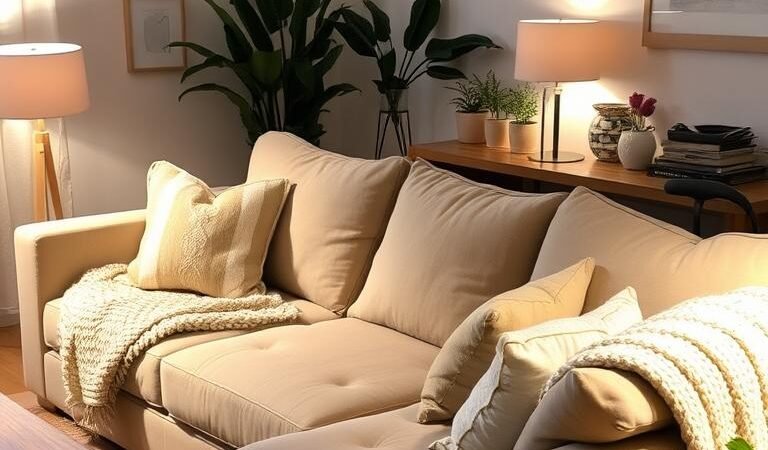Transforming your home into a relaxing retreat starts with the right details. Designer Alessandra Wood notes, “Creating a natural living room cultivates peace…be intentional with proportions and shapes.” This approach ensures harmony in every corner.
Soft colors and textures play a key role in setting the mood. Earthy tones connect with nature, while layered lighting—like table lamps and candles—adds depth. These choices enhance both comfort and style.
Sustainability also matters. Repurposing vintage fabrics brings character while reducing waste. Every material, from plush rugs to breathable linens, contributes to a calming atmosphere.
Key Takeaways
- Intentional design creates a peaceful and balanced space.
- Soft colors and natural textures improve relaxation.
- Layered lighting adds warmth and dimension.
- Earthy tones align with biophilic design principles.
- Upcycled textiles offer sustainable charm.
1. Embrace Warm and Earthy Color Palettes
Earthy tones bring nature’s calm indoors, setting a soothing mood. These hues—think terracotta, ochre, and sage green—connect spaces to the outdoors. They evoke comfort and balance, making them ideal for relaxation.
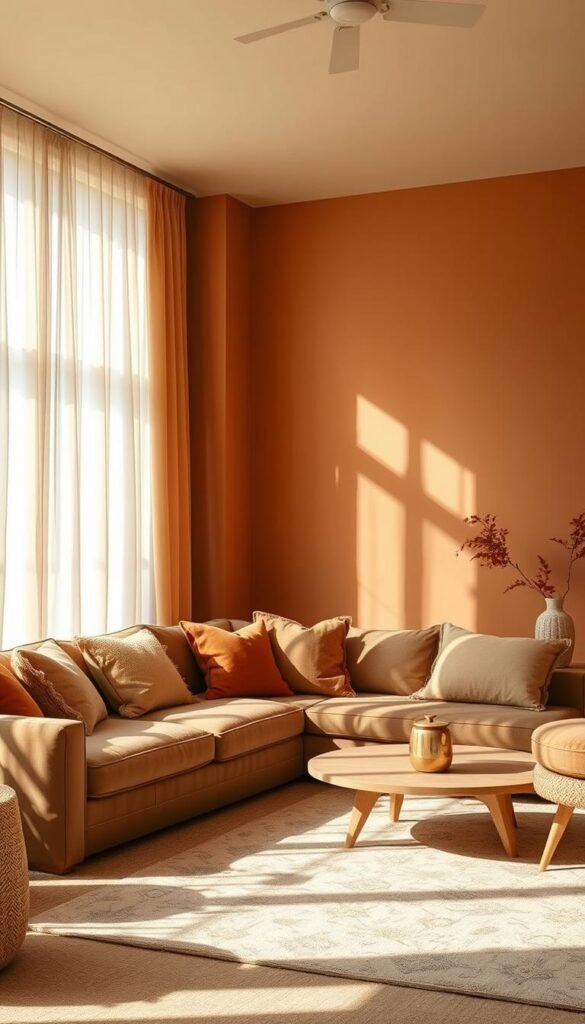
Why Earthy Tones Work
Warm tones like terracotta stimulate warmth, while sage green promotes tranquility. Designers often use these shades to anchor a space. Darker hues, such as moody blues, add sophistication without overwhelming.
Best Paint Colors for Coziness
Neutrals like Farrow & Ball’s *”Cornforth White”* or *”Ammonite”* serve as versatile bases. For drama, try Benjamin Moore’s Hale Navy on an accent wall. Stephenie Watts’ ceiling-painting experiment shows how overhead color enhances intimacy.
| Warm Tones | Cool Tones | Best Use |
|---|---|---|
| Terracotta | Hale Navy | Accent walls |
| Ochre | Cornforth White | Neutral backdrops |
| Sage Green | Ammonite | Ceilings/trim |
Pro Tip: Color drenching—painting walls, trim, and ceilings the same shade—creates an immersive effect. Match textiles to walls for a harmonious look.
2. Layer Soft Textiles for Ultimate Comfort
Comfort begins with tactile textures that welcome you home. Start with a rug base—like Janine Genower’s vibrant orange retro piece—to ground the space. Leave 18–24 inches of flooring visible around furniture for balance.
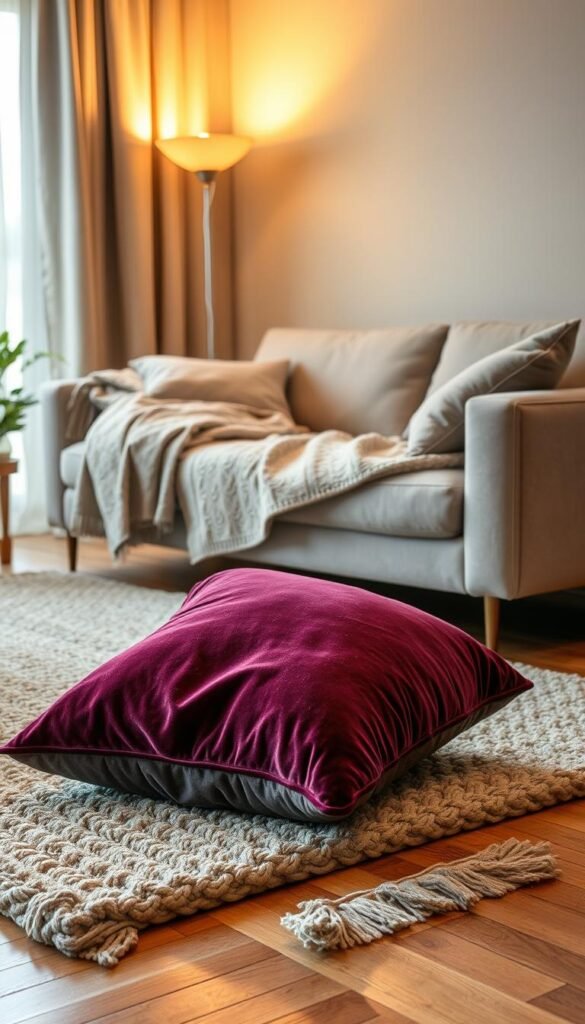
Throw Pillows and Blankets
Build upward with throw pillows in varying sizes. Wool offers durability, cotton breathes easily, and faux fur adds a cloud-like embrace. For pet-friendly options, try tightly woven velvet or outdoor fabrics.
Drape chunky knit blankets over sofas or storage ottomans. Helen Sellwood recommends vintage markets for unique, budget-friendly finds.
Plush Rugs and Curtains
Anchor seating areas with natural fiber rugs for earthy appeal. Layer sheepskin atop larger rugs for contrast. Floor-to-ceiling velvet curtains soften noise and light, as seen in Genower’s Mexican-inspired collection.
Pro Tip: Rotate textiles seasonally—linen for summer, wool for winter—to refresh your space effortlessly.
3. Master the Art of Soft Lighting
Lighting transforms a space from functional to inviting with just a few adjustments. Layered lighting adds depth, while warm bulbs enhance the feel of a room. Designer Roman Plyus’ minimalist approach proves even small changes make a big impact.
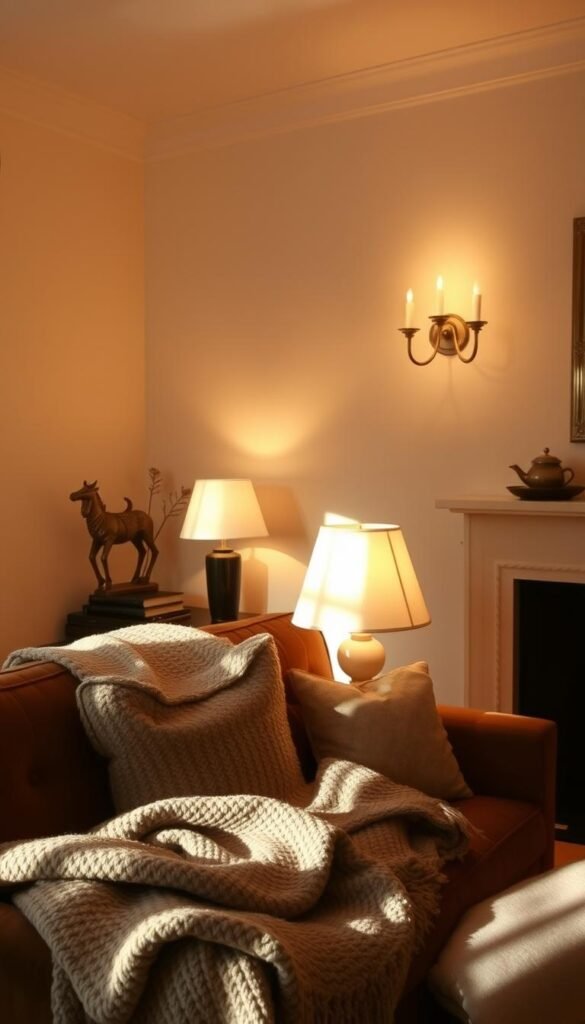
Table Lamps and Floor Lamps
Choose lamps with adjustable brightness for versatility. A midcentury modern floor lamp, like those in Anthony Baratta’s Utah lodge, offers both style and function. Place table lamps at eye level when seated—about 24–30 inches tall.
Lighting by Room Size:
| Room Size (sq ft) | Recommended Lumens | Bulb Type |
|---|---|---|
| 100–200 | 1,500–3,000 | LED (warm white) |
| 200–400 | 3,000–6,000 | Incandescent |
String Lights and Candles
Twinkling string lights add whimsy to bookshelves or windows. For safety, opt for battery-operated LEDs near curtains. Candles create instant coziness—use trays under them on wooden surfaces to prevent damage.
- Dimmer switches let you adjust ambiance for any occasion.
- Incandescent bulbs emit warmer light than LEDs but use more energy.
- Cluster candles in groups of three for visual balance.
Pro Tip: Match bulb color temperatures (2700K–3000K) throughout the space for harmony.
4. Incorporate Natural Materials
Nature’s raw beauty brings depth and authenticity to any space. From reclaimed beams to hand-thrown pottery, organic elements infuse warmth into modern design. These materials age gracefully, telling stories through their imperfections.
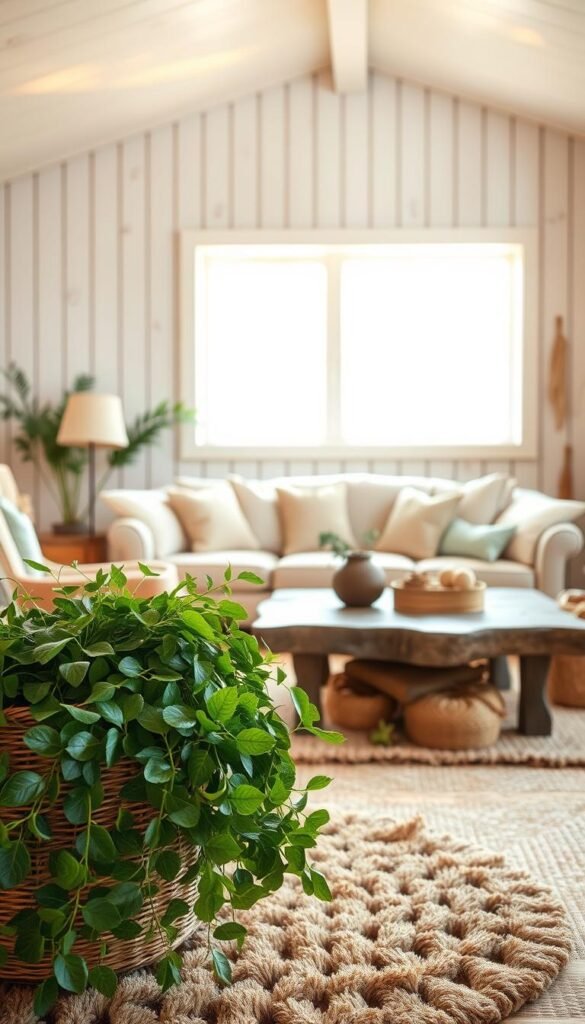
Wood and Wicker Accents
Wood species like oak, walnut, and bamboo each offer unique benefits. Oak’s durability suits high-traffic areas, while walnut’s rich grain elevates furniture. Bamboo, a fast-growing grass, is ideal for eco-conscious projects.
Designer Megan Marsh’s “world’s largest coat rack” showcases reclaimed timber’s potential. Her 12-foot piece uses 1800s Massachusetts mill beams—proof that vintage materials shine in contemporary spaces.
| Wood Type | Best For | Maintenance |
|---|---|---|
| Oak | Flooring, tables | Regular oiling |
| Walnut | Statement furniture | Dust with microfiber |
| Bamboo | Shelving, accents | Avoid excess moisture |
Stone and Clay Decor
Limewash treatments create modern rustic walls with subtle texture. Jason Frank pairs weathered leather with raw wood, embodying midcentury modern simplicity. “Materials should feel lived-in,” he notes.
Try DIY clay pot texturing: Score damp clay with burlap for a tactile finish. Debra Koehler’s mantel, crafted from her family’s orchard wood, proves sustainability meets legacy.
- Certifications matter: Look for FSC (wood) or Cradle to Cradle (clay).
- Wicker thrives in humid spaces like sunrooms.
- Stone veneers offer lightweight drama.
5. Choose the Right Furniture for Comfort
Furniture choices make or break the functionality of any area. In a house designed for relaxation, every piece should invite you to sit longer. The secret lies in balancing proportions with plush comfort.
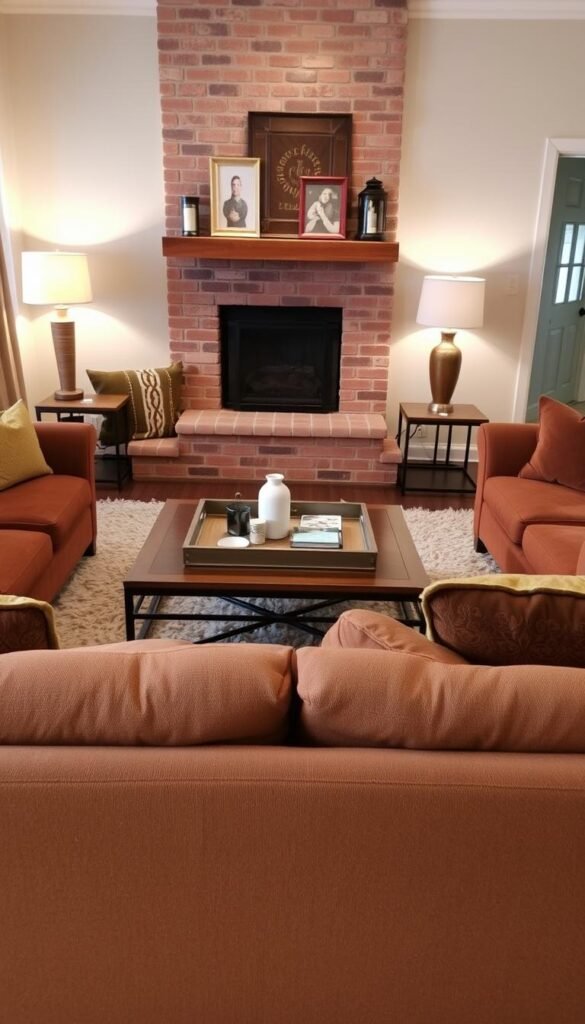
Plush Sofas and Armchairs
Seat depth matters more than you think. Designer Bambi Costanzo’s IKEA sectional hack proves 22-24 inches provides optimal thigh support. Her custom cushions transformed a basic frame into a lounge-worthy centerpiece.
Leather expert Jason Frank recommends monthly conditioning for longevity. “Untreated leather dries out faster than people realize,” he notes. For pet owners, tightly woven fabrics like Crypton resist claws better than loose weaves.
| Type | Best For | Maintenance |
|---|---|---|
| Modular Sectional | Large spaces | Vacuum crevices weekly |
| Armchair | Reading nooks | Rotate cushions |
| Sleeper Sofa | Multi-use areas | Lubricate mechanism yearly |
Ottomans and Floor Seating
Multifunctional ottomans solve two needs: extra seating and hidden storage. Look for versions with lift-up lids—perfect for blankets or board games. Designer Lila Hayes suggests pairing them with 4-inch floor cushions for flexible gatherings.
Consider these dimensions for comfort:
- Coffee tables: 18-20 inches high complements most sofas
- Floor pillows: 24×24 inches minimum for adult seating
- Benches: 15-18 inches deep for proper support
Pro Tip: Test furniture in-store by sitting for 10+ minutes. Discomfort that seems minor at first often becomes unbearable over time.
6. Create a Cozy Reading Nook
Every book lover deserves a spot designed just for literary escapes. Whether it’s a bay window or an unused corner, 36×36 inches forms the ideal minimum footprint. @peachy__home’s boho-inspired space proves even compact areas can become inviting retreats.
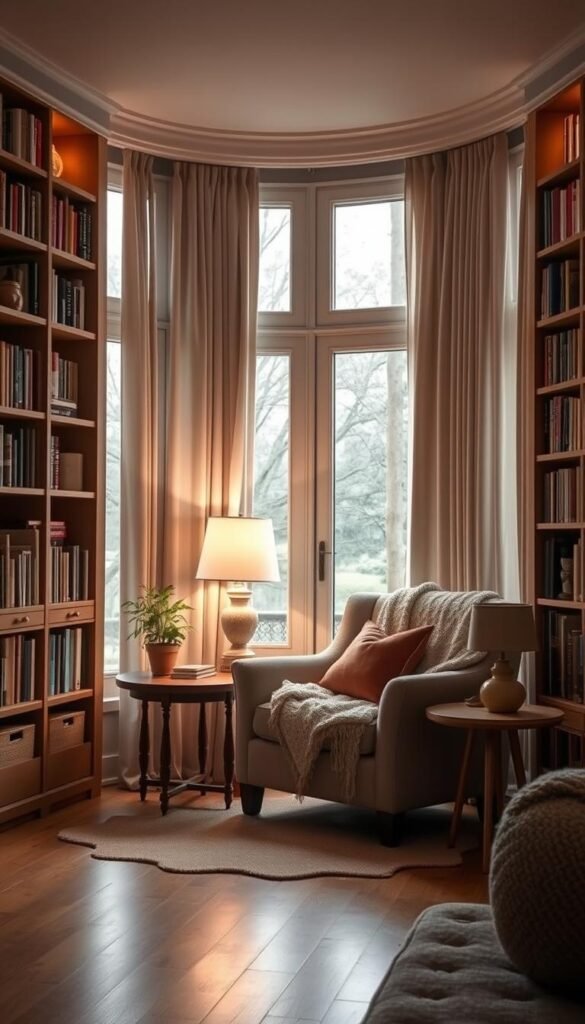
Perfect Chair and Lighting
Annie Schlechter’s daybed design demonstrates how depth matters—22-inch cushions support extended reading sessions. For proper ergonomics, choose chairs where knees bend at 90 degrees when feet touch the floor.
Compare lighting options:
- Swing arm lamps direct light precisely without glare
- Adjustable floor lamps (like those in Schlechter’s projects) offer flexibility
- LED book lights provide 500-800 lumens for evening reading
Adding Personal Touches
Amy Whyte’s fox-themed decor shows how whimsy enhances personality. Display vintage books spine-out for color, or stack them as side tables. For window seats, medium-firm cushions (4-inch density) balance comfort and support.
Storage solutions keep essentials handy:
- Basket under chairs for lap blankets
- Wall-mounted shelves for current reads
- Small side tables with charging stations
Layer textures with knitted throws over linen chair covers. This approach makes the space feel cozy while serving practical needs.
7. Use Dark Tones for a Snug Atmosphere
Dark tones create instant sophistication, wrapping spaces in rich elegance. Deep hues like navy and charcoal add depth while maintaining warmth. Designers often use these colors to craft intimate, inviting environments.
The 60-30-10 Rule for Balance
Apply this classic design ratio to dark palettes: 60% dominant (walls), 30% secondary (furniture), and 10% accent (decor). Eggshell finishes softly diffuse light, while matte absorbs it for drama. Stephenie Watts’ navy ceiling demonstrates how overhead color unifies a space.
Reflective Finishes and Metallic Accents
Pair dark walls with brass or gold touches to prevent heaviness. Watts’ Facebook Marketplace chair—reupholstered in velvet—shows how metallics elevate thrifted finds. Mirrors placed opposite windows amplify natural light.
- Maintenance: Dust dark walls weekly with microfiber to avoid streaks.
- Pigment choice: Charcoal offers subtle warmth; black iron oxide reads cooler.
- Small room trick: Paint only the lower half of walls to keep airiness.
“Dark colors demand confidence but reward with unmatched coziness,” notes Watts. Test swatches at different times of day to ensure the desired feel.
8. Add Greenery for a Fresh Feel
Plants breathe life into a home, transforming sterile corners into vibrant retreats. Whether you’re a seasoned plant parent or a beginner, greenery enhances air quality and natural materials like wood and stone. Designer Romalyn’s urban jungle proves even small spaces can flourish with foliage.
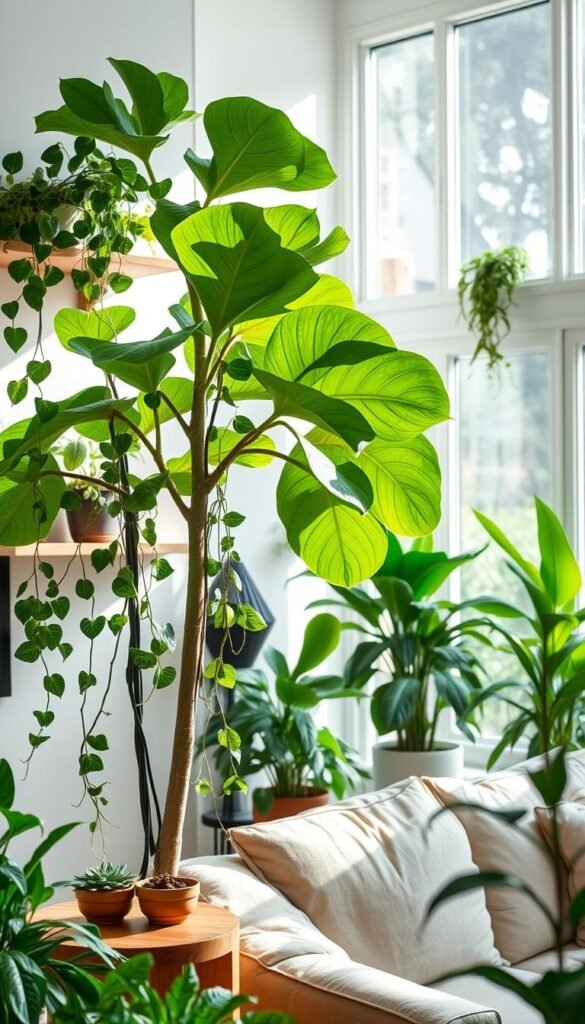
Low-Maintenance Indoor Plants
For busy lifestyles, pothos and snake plants thrive on neglect. Pothos trails elegantly from shelves, while snake plants purify air vertically. Compare their care needs:
| Plant | Light | Water | Pet-Safe? |
|---|---|---|---|
| Pothos | Low-indirect | Weekly | No |
| Snake Plant | Any | Bi-weekly | Yes |
Jeannette Fristoe’s displays feature spider plants—safe for cats and adaptable to hanging baskets. For self-watering solutions, try ceramic pots with reservoirs.
Hanging Planters and Shelves
Macramé hangers support up to 10 lbs, ideal for lightweight ferns. Stefanie Zielke’s ceiling-hung greenery adds drama without floor space. For renters, adhesive shelves hold 5-inch pots securely.
- Vertical gardens: Use modular panels for herbs or succulents.
- Weight limits: Ensure hooks anchor into studs for heavy planters.
- Light access: Rotate plants weekly for even growth.
Pro Tip: Group plants by humidity needs—e.g., ferns with pebble trays—to simplify care.
9. Mix and Match Textures
Texture blending elevates design by engaging multiple senses at once. A 3:2:1 ratio creates balance—three large textures (like a rug), two medium (e.g., pillows), and one accent (such as a stone wall). Designer Maria Carr’s whitewashed wood technique shows how weathered finishes add rustic charm.
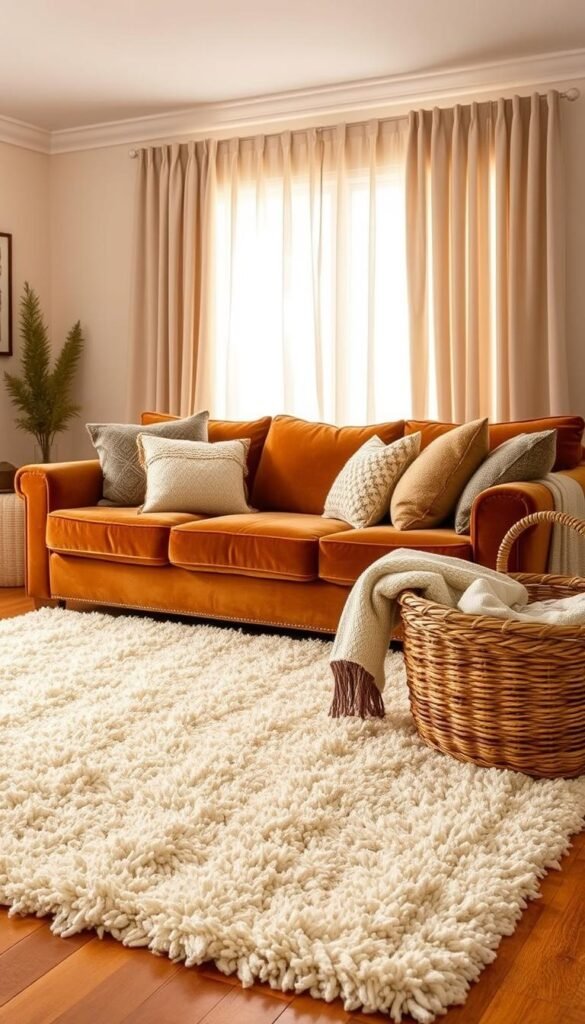
Velvet, Knit, and Linen
Linen’s open weave offers breathability, while cotton’s tight weave resists wrinkles. For contrast, pair polished marble tables with nubby wool throws. Stefanie Zielke’s projects mix sleek leather sofas with rattan chairs—proof that opposites attract.
- Cleaning codes: Match high-traffic fabrics (Crypton) with low-maintenance surfaces.
- Layering trick: Drape a chunky knit blanket over a velvet armchair.
- Color unity: Keep tones consistent to avoid visual chaos.
Combining Rough and Smooth
Amy Meier’s lakeside scheme pairs driftwood coffee tables with linen curtains. For walls, stone veneers add rugged depth. Janine Genower’s retro orange rug proves bold textures anchor a space effortlessly.
| Texture Pairing | Best For |
|---|---|
| Polished metal + Bouclé | Modern spaces |
| Reclaimed wood + Sheepskin | Rustic cabins |
Pro Tip: Test combinations by touch—if textures feel harmonious together, they’ll look cohesive too.
10. Opt for a Monochromatic Scheme
Limiting your color choices can actually expand your design possibilities. A single-hue approach creates visual harmony while allowing texture and form to shine. As James Farmer notes, “Monochromatic spaces feel curated rather than chaotic—every element intentionally supports the whole.”
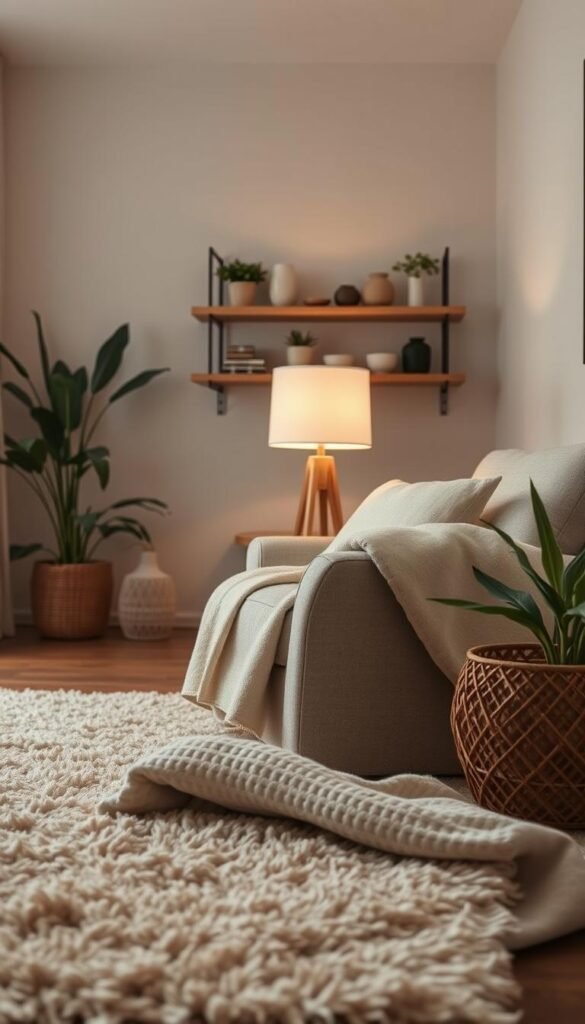
Benefits of One-Color Design
Monochromatic differs from tonal schemes in its strict adherence to one base color. While tonal designs use related hues, monochromatic focuses on value changes—light to dark variations of the same pigment.
Roman Plyus demonstrates this with his airy white and beige palette. The subtle gradation from cream walls to oatmeal textiles creates depth without visual competition. This approach works particularly well in small spaces where multiple colors might overwhelm.
Adding Depth with Shades
Successful monochromatic design relies on a 5-shade gradient system:
| Shade Level | Application | Effect |
|---|---|---|
| 10% (lightest) | Ceilings, trim | Opens space |
| 30% | Walls | Neutral backdrop |
| 50% | Large furniture | Visual anchor |
| 70% | Accent pieces | Adds contrast |
| 90% (darkest) | Decorative objects | Creates drama |
Metallic finishes add dimension without breaking the color rule. Brushed brass hardware or mercury glass accessories reflect light differently than matte surfaces. Helen Sellwood’s maximalist approach layers these textures boldly—velvet drapes against lacquered walls create luxurious contrast.
For small rooms, limit the darkest shade to 10% of surfaces. Paint walls in the 30% value and use deeper tones in movable items like throw pillows. This maintains the scheme’s sophistication while preventing a cave-like feel.
Pro Tip: Vary sheens within your color family—matte walls with glossy trim adds subtle interest. Test samples at different times of day to ensure the palette works in all lighting conditions.
11. Personalize with a Gallery Wall
Walls become conversation starters when adorned with meaningful artwork collections. This design element turns blank spaces into visual autobiographies—where every piece tells part of your story. Designer Holly Audrey Williams’ church banner installation proves even unconventional items can become striking displays.
Curating Your Collection
Follow the 60-30-10 formula for balanced displays: 60% art, 30% photos, and 10% dimensional objects like wall sculptures. Rachel Hardage Barrett’s piano wall layout mixes antique sheet music with family portraits for nostalgic charm.
Frame choices unify diverse pieces:
- Matte black creates modern cohesion
- Mixed metals add eclectic energy
- Floating frames highlight delicate works
Mastering the Layout
For plaster walls, distribute weight evenly using multiple small anchors rather than single heavy-duty hooks. Maintain 2-3 inches between pieces—this spacing creates rhythm without overcrowding.
Compare arrangement approaches:
| Grid Style | Organic Style |
|---|---|
| Precise alignment | Asymmetrical balance |
| Uniform frame sizes | Mixed dimensions |
| Modern aesthetic | Bohemian feel |
Theme unification techniques:
- Color-wash photos for tonal harmony
- Repeat one material (e.g., wood frames)
- Group by subject matter (travel, family)
Whether creating a salon-style mix or minimalist grid, let your home reflect what moves you. As Williams demonstrates with her textile displays, rules matter less than emotional connection.
12. Incorporate Vintage and Secondhand Finds
Secondhand treasures add soul to any space, telling stories through their imperfections. A 70/30 mix—70% vintage to 30% new—creates curated depth without overwhelming. Tina Bousu’s Facebook Marketplace strategies prove online thrifting yields designer-quality furniture at garage-sale prices.
Thrifting Like a Pro
Map out thrifting routes clockwise to hit estate sales early. Focus on neighborhoods with midcentury homes for period-appropriate pieces. Bousu recommends these search hacks:
- Keyword combos: “Danish teak” + your city
- Timing: Refresh listings at 8 AM when new posts appear
- Negotiation: Bundle multiple items for 15-20% discounts
Breathing New Life Into Old Finds
Bambi Costanzo transformed a 1920s kitchen table into a console by lowering the base 12 inches. Her project illustrates three repurposing principles:
- Preserve original hardware when possible
- Sand with 120-grit paper before refinishing
- Test stains on underside first
| Finish Type | Drying Time | Best For | Toxicity |
|---|---|---|---|
| Chalk Paint | 1 hour | Distressed looks | Low-VOC |
| Milk Paint | 30 minutes | Antique reproduction | Non-toxic |
| Latex | 4 hours | Modern updates | Ventilation needed |
Debra Koehler’s mantel—crafted from her family’s apple orchard wood—shows how reclaimed materials anchor a home. Always check for structural integrity:
- Joinery: Dovetail joints indicate quality
- Woodworm: Tap for hollow sounds
- Lead paint: Test kits cost $10 at hardware stores
Pro Tip: Layer eras intentionally—pair a Victorian mirror with a sleek modern bench. The contrast highlights each piece’s unique character.
13. Blend Midcentury Modern and Boho Styles
Design boundaries dissolve when structured silhouettes meet free-spirited accents. This fusion creates spaces where clean lines complement organic textures—think walnut credenzas draped with macramé. Designer Stefanie Zielke proves these seemingly opposite styles share common ground through natural materials and intentional craftsmanship.
Key Elements of Each Style
Midcentury modern prioritizes function with tapered legs and geometric shapes. Signature furnishings include:
- Eames-style molded chairs
- Teak media consoles
- Sputnik chandeliers
Boho decor embraces layered textures and global influences. Anthony Baratta’s lumberjack fabric use shows how bold patterns anchor spaces. Key markers:
- Rattan pendant lights
- Kilim floor pillows
- Terracotta planters
Creating Harmony
Zielke’s glass coffee table paired with nubby rattan chairs demonstrates balance. Follow these wood tone coordination techniques:
| MCM Wood | Boho Pairing | Effect |
|---|---|---|
| Walnut | Light oak | Warm contrast |
| Teak | Bamboo | Textural play |
Scale patterns thoughtfully—pair large geometric prints with small ikat motifs. For hardware, try:
- Brass pulls on MCM dressers
- Leather straps on boho cabinets
Hanging plants soften angular furniture, while woven baskets store MCM magazines. This mix proves design eras can coexist beautifully.
14. Install a Statement Fireplace
A fireplace anchors any room, blending warmth with striking design. Whether modern or traditional, it becomes the heart of a home, offering both visual appeal and practical comfort. Third-source moss rock fireplaces prove natural materials elevate this feature.
Modern vs. Traditional Options
Ventless ethanol inserts suit contemporary spaces with clean lines—no chimney required. Electric alternatives offer realistic flames at the touch of a button. For rustic charm, designer Amy Whyte’s fox-shaped grate discovery adds whimsy to classic brick.
Compare heat outputs:
- Ethanol: 6,500 BTU/hr (heats 400 sq ft)
- Electric: 5,200 BTU/hr with adjustable thermostat
- Wood-burning: 25,000+ BTU/hr (requires 36″ clearance)
Mantel Design Mastery
Megan Marsh’s reclaimed timber “coat rack” mantel demonstrates creative repurposing. Follow the 1/3 rule: mantel width should equal one-third of the wall’s total width. This proportion balances the area without overwhelming.
For non-working fireplaces, try these designer solutions:
- Stack birch logs for texture
- Display art on a leaning ladder
- Fill the hearth with drought-tolerant succulents
Rotate decor seasonally—ceramic vases in spring, woven baskets in fall. Always maintain 12 inches between flammable items and heating elements. This ensures safety while letting your furniture arrangement feel cohesive.
Pro Tip: Paint the firebox interior matte black to create depth in unused units. It’s an instant upgrade that complements any walls.
15. Use Mirrors to Enhance Light
Mirrors work like magic—doubling light and expanding any space with just a glance. When positioned correctly, they amplify natural light and create the illusion of depth. Designer Maria Carr’s white-painted mirror wall demonstrates how reflective surfaces can become a room’s focal point.
Placement Strategies
Calculate light refraction angles by placing mirrors opposite windows or blank walls. Annie Schlechter’s library installation bounces sunlight across bookcases—a clever way to brighten dark corners. For feng shui alignment, avoid reflecting cluttered areas or sharp furniture edges.
Consider these installation methods:
- Leaning: Creates casual elegance on mantels or consoles
- Hanging: Ideal for eye-level placement in hallways
- Grouped: Cluster smaller mirrors for gallery-style impact
Choosing the Right Mirror
Frame materials elevate decor while serving functional needs. Compare options:
| Material | Best For | Maintenance |
|---|---|---|
| Wood | Rustic or midcentury spaces | Dust weekly |
| Metal | Modern interiors | Polish monthly |
| Resin | Humid areas like bathrooms | Wipe with damp cloth |
Check glass quality by looking for:
- Distortion-free surfaces: View your reflection from multiple angles
- Beveled edges: Adds depth and catches light beautifully
- UV protection: Prevents artwork fading in sunlit rooms
Pro Tip: Gold-framed mirrors add warmth, while black frames modernize traditional spaces. Rotate seasonal decor in the reflection zone to keep the feel fresh.
16. Conclusion
Designing a welcoming space is about balancing aesthetics with personal comfort. Layer textures for tactile appeal, soften lighting for warmth, and choose hues that soothe the eye. These elements create a cozy living room that feels uniquely yours.
Skip fleeting trends—opt for pieces that tell your story. Start small: swap throw pillows or test paint samples. Apps like DecorMatters help visualize changes before committing.
Sustainability matters. Repurpose vintage finds or upcycle fabrics to reduce waste. As Alessandra Wood notes, “Intentional design cultivates peace—one thoughtful choice at a time.”
Ready to refresh your home? Pick one change today to feel cozy in your renewed sanctuary. Explore more living room ideas to keep the inspiration flowing.
